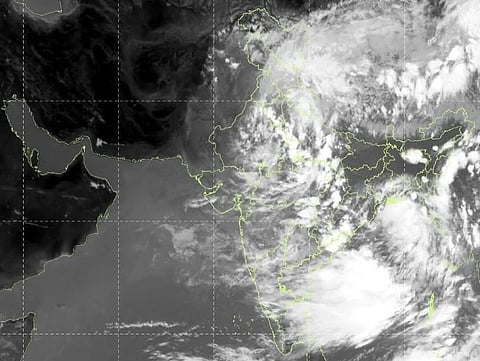

In a potential meteorological anomaly, Southwest Monsoon winds may have crossed the Himalayas into Tibet, challenging the traditional role of the mountains as a barrier.
This rare event, observed via satellite, could indicate significant climate shifts, possibly influenced by global warming, altering fundamental weather patterns in the region.
The winds of the Southwest Monsoon (SWM) season may have possibly crossed the western Himalayan mountain range and reached Tibet, according to a scientifically trained observer. If this has indeed happened, it would be an extraordinary meteorological event.
This is because the existence of the monsoon and its activity over India is predicated upon the Himalayas acting as a barrier and keeping the moisture-laden winds within India. Hence the Tibetan plateau is not affected by the monsoon and is arid. The little precipitation in the form of snow that the region gets, comes in the winter and spring from western disturbances.
Manish Mehta, a glaciologist with the Wadia Institute of Himalayan Geology (WIHG) and currently in Ladakh, surmises from a satellite map showing moisture in the first week of September that the SWM moisture crossed the Himalayas. “You can see in the map that moisture moves towards Tibet from above Himachal Pradesh, Uttarakhand and Ladakh,” he told Down To Earth (DTE).
DTE queried two climate scientists about the possibility of monsoon winds crossing the Himalayas and reaching Tibet and how rare such an event could be.
“We have to be careful about inferring moisture transport based on such images, but it is reasonable to assume that strong advection into the Himalayan foothills will create rising air, expansion and heating. That leads to cloudbursts but may also lead to further advection northward. You have to look at the topography along this path to see if there are gaps in the mountains where this path is being followed,” said Raghu Murtugudde from Indian Institute of Technology Bombay and University of Maryland.
Roxy Mathew Koll from Indian Institute of Tropical Meteorology Pune said, “It is possible that the extratropical weather systems — via western disturbances or atmospheric rivers (subtropical jet stream) — interact with the moisture load from the monsoon and take it beyond the subcontinent. I do not have information on whether this is an outlier or not.”
There have been 19 western disturbances during the SWM season. Three of these formed in the first week of September. The interaction of the western disturbance and the monsoon winds could have taken the moisture across the Himalayas. Western disturbances during the SWM are rare and their increased frequency this year is an active area of research. But it could be influenced by global warming and consequent climate change.
If the monsoon crossing the Himalayas has occurred, it would be further proof that warming caused by the emissions of greenhouse gases is changing some of the most fundamental climatic processes that have wide ranging impacts on the entire region.